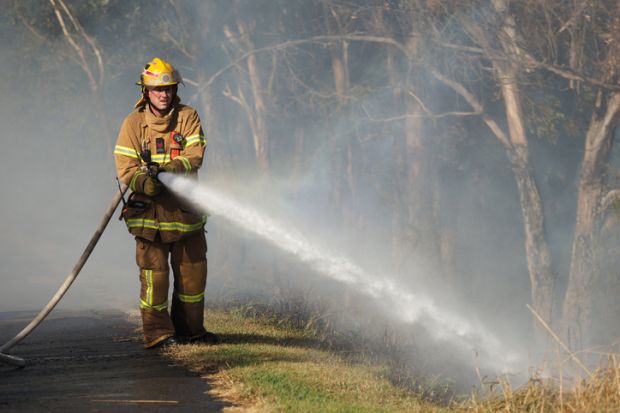Australia’s bushfire emergency has highlighted universities’ role as refuges for communities experiencing natural disasters.
Regional university campuses across the country have provided crisis accommodation or put beds on standby for firefighters and evacuees, have harboured and treated animals and have served as operational centres for supplying firefighters and coordinating fundraising appeals.
Normal operations were suspended at the University of Wollongong’s campuses on the south coast of New South Wales, an epicentre of fire activity over the Christmas and New Year period, with the Batemans Bay and Bega campuses set aside as refuges for displaced residents, students and holidaymakers who could not be accommodated in the main community evacuation centres.
The university said some staff had “worked tirelessly to serve their communities” even though their own homes were in the path of – and in some cases, overrun by – the flames.
“Many of our students come from areas affected or under threat,” said vice-chancellor Paul Wellings. “The university stands with the community as we confront this unprecedented emergency.”
Charles Sturt University has accommodated firefighters at its Port Macquarie campus and put about 1,000 beds on standby for evacuees in Bathurst, Orange, Wagga Wagga and Albury.
“I want staff, students and local communities to know that we are here to help, and we will continue to provide support and increase our support as it is needed,” said acting vice-chancellor John Germov.
Jim McLennan, a psychologist and bushfire safety researcher with La Trobe University in Melbourne, said university campuses were “ideally placed” to serve as refuges in towns threatened by fire.
He said university buildings’ construction and location “typically remote from heavily forested areas” made them safer than many other areas, and campuses were largely vacated during the peak summer fire period.
Nevertheless, the scope of the emergency could cause some to reassess the viability of studying and even living in fire-prone bushland areas. Although casualties so far remain much lower than the tolls of disasters such as the 2009 Black Saturday fires and 1983’s Ash Wednesday, the extent and longevity of the crisis is unprecedented.
The blazes have raged in every state, scorching more than 100,000 square kilometres – an area bigger than South Korea – and killing or dooming an estimated 1 billion animals. Unlike previous short-lived catastrophes, the crisis began just after the southern winter and shows no signs of abating before autumn.
The University of Southern Queensland lost gardens and equipment at its Queensland College of Wine Tourism when fire torched nearby houses in early September. Chief executive Peter O’Reilly said greater damage had been inflicted when a subsequent bushfire closed the main road from Brisbane.
He said the college relied on income from its training restaurant. “The locals don’t have any cash, and the tourists can’t get here. The whole place is having the life strangled out of it,” he said.
University coffers are also covering the scholarships and financial assistance provided to fire-affected students and the special leave arrangements for staff who are fighting the fires or have lost their homes.
While many universities award extra leave on a case-by-case basis, Flinders University announced up to four weeks’ additional entitlement for volunteers and victims. “My thoughts are with all of those already affected and those still under threat,” said vice-chancellor Colin Stirling.




